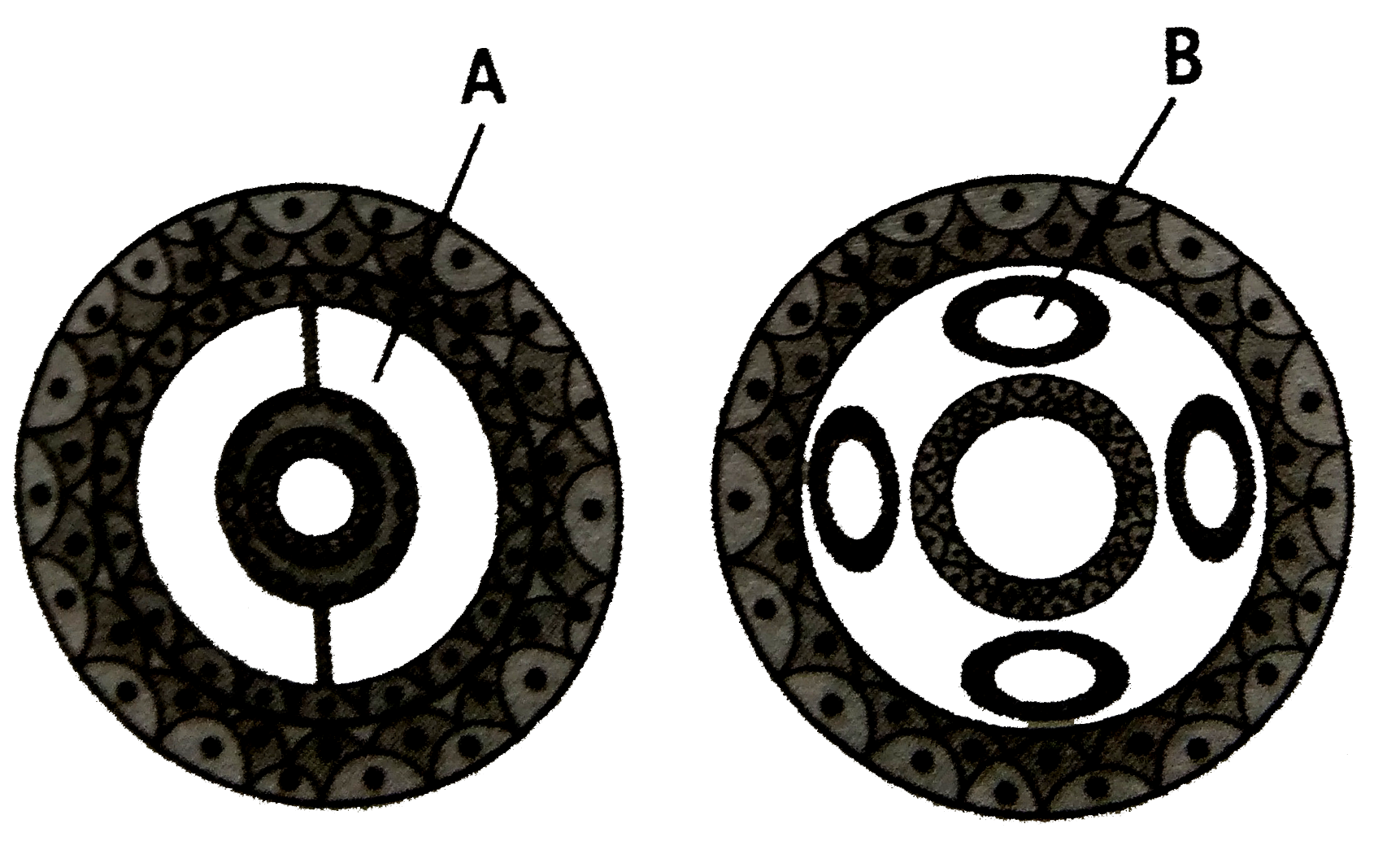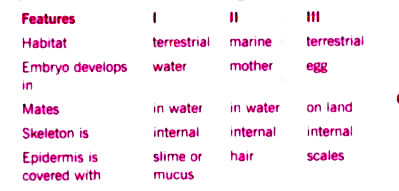Read the given statements characterizing certain types of animals. Select the option which correctly exemplifies each of these types.
(i) Animal having external gills
(ii) Animal having internal gills
(iii) Animal showing tracheal respiration
(iv) Animal revealing buccopharyngeal respiration
(i)(ii)(iii)(iv)PrawnArenicolaUnioFish
(i)(ii)(iii)(iv)NecturusUnioPrawnFrog
(i)(ii)(iii)(iv)PilaArenicolaUnioToad
(i)(ii)(iii)(iv)NecturusPilaMilipedeToad
The correct Answer is:D
To solve the question regarding the types of animals based on their respiratory structures, we will analyze each statement and identify the correct examples for each type of respiration.
1. Animal having external gills:
- External gills are projections from the body surface and are not enclosed by the body wall. They are typically found in certain larval forms of amphibians and some aquatic organisms.
- Among the options provided (Prawn, Necturus, Pila, Necturus), Necturus is the correct answer. Necturus is a genus of aquatic salamanders that possess external gills during their larval stage.
2. Animal having internal gills:
- Internal gills are covered and protected by soft skin folds, such as the interbranchial septum or operculum. They are found in certain mollusks and some aquatic organisms.
- The options provided are (Arnicola, Unio, Arnicola, Pila). Pila, which is the scientific name for the apple snail, is known to have internal gills (also called tinnidium) that allow it to respire in water.
3. Animal showing tracheal respiration:
- Tracheal respiration involves a system of air-filled tubes (trachea) that facilitate gas exchange in certain arthropods, including insects and myriapods.
- The options given are (Unio, Prawn, Unio, Millipede). The correct answer is Millipede, as it is a group of arthropods that utilize tracheal respiration.
4. Animal revealing buccopharyngeal respiration:
- Buccopharyngeal respiration occurs through the lining of the mouth and is characteristic of certain amphibians, particularly frogs, when they are not submerged in water.
- The options provided are (Fish, Frog, Toad, Toad). The correct answer is Toad, as it also exhibits buccopharyngeal respiration.
Final Answers:
- (i) Necturus (external gills)
- (ii) Pila (internal gills)
- (iii) Millipede (tracheal respiration)
- (iv) Toad (buccopharyngeal respiration)
- External gills are projections from the body surface and are not enclosed by the body wall. They are typically found in certain larval forms of amphibians and some aquatic organisms.
- Among the options provided (Prawn, Necturus, Pila, Necturus), Necturus is the correct answer. Necturus is a genus of aquatic salamanders that possess external gills during their larval stage.
- Internal gills are covered and protected by soft skin folds, such as the interbranchial septum or operculum. They are found in certain mollusks and some aquatic organisms.
- The options provided are (Arnicola, Unio, Arnicola, Pila). Pila, which is the scientific name for the apple snail, is known to have internal gills (also called tinnidium) that allow it to respire in water.
- Tracheal respiration involves a system of air-filled tubes (trachea) that facilitate gas exchange in certain arthropods, including insects and myriapods.
- The options given are (Unio, Prawn, Unio, Millipede). The correct answer is Millipede, as it is a group of arthropods that utilize tracheal respiration.
- Buccopharyngeal respiration occurs through the lining of the mouth and is characteristic of certain amphibians, particularly frogs, when they are not submerged in water.
- The options provided are (Fish, Frog, Toad, Toad). The correct answer is Toad, as it also exhibits buccopharyngeal respiration.
- (i) Necturus (external gills)
- (ii) Pila (internal gills)
- (iii) Millipede (tracheal respiration)
- (iv) Toad (buccopharyngeal respiration)
Topper's Solved these Questions
- BOOK - NCERT FINGERTPS ENGLISHCHAPTER - BREATHING AND EXCHANGE OF GASESEXERCISE - Higher Order Thinking12videos
BREATHING AND EXCHANGE OF GASES
- BOOK - NCERT FINGERTPS ENGLISHCHAPTER - BREATHING AND EXCHANGE OF GASESEXERCISE - Exemplar Problems13videos
BREATHING AND EXCHANGE OF GASES
- BOOK - NCERT FINGERTPS ENGLISHCHAPTER - BODY FLUIDS AND CIRCULATIONEXERCISE - Body Fluids And Circulation151videos
BODY FLUIDS AND CIRCULATION
- BOOK - NCERT FINGERTPS ENGLISHCHAPTER - CELL - THE UNIT OF LIFEEXERCISE - Cell - The Unit Of Life159videos
CELL - THE UNIT OF LIFE
Similar Questions
Select the correct option that represents examples of the following types of animals.
(i) Roundworm
(ii) Fish possessing poison string
(iii) A limbless amphibian
(iv) An oviparous mammalView SolutionSelect the option in which given three parameters are not correctly matched Animals Breed Product
View Solution
Knowledge Check
- Question 1 - Select One
Select the correct option that represents examples of the following types of animals.
(i) Cold blooded animal
(ii) Warm blooded animal
(iii) Animal possessing dry and cornified skin
(iv) Hermaphrodite animal.A(i) (ii) (iii) (iv)Forg Pigeon Wall lizard EarthwormB(i) (ii) (iii) (iv)Pigeon Frog Crocodile HydraC(i) (ii) (iii) (iv)Rabbit Fish Frog EarthwormD(i) (ii) (iii) (iv)Fish Frog wall lizard Starfish - Question 2 - Select One
Q) Refer to the given figure which shows sectional view of two types of coelom A and B. Select the correct option which represents groups of animals that possess A or B
 Aa) A - Aschelminthes adn Annelids ,B - Echinoderms and ChordatesBb) A - Annelids, Echinoderms and Chordates ,B - AschelminthesCc) A - Echinoderms and Chordates ,B - Aschelminthes and AnnelidsDd) A - Aschelminthes ,B - Annelids, Echinoderms and Chordates
Aa) A - Aschelminthes adn Annelids ,B - Echinoderms and ChordatesBb) A - Annelids, Echinoderms and Chordates ,B - AschelminthesCc) A - Echinoderms and Chordates ,B - Aschelminthes and AnnelidsDd) A - Aschelminthes ,B - Annelids, Echinoderms and Chordates - Question 3 - Select One
Select the correct statement
ABoth statements 1 and 2 are correct.BStatement 1 is correct but statements 2 is incorrect.CStatement 1 is incorrect but statement 2 is correctDBoth statements 1 and 2 are incorrect
Which type of animals have severe effect of change in temperature of environment?
View SolutionRead the following statements and select the correct option
(a) All triploblastic animals are eucoelomates
(b) They have a false coelom .View SolutionCharacteristics of three animals are given below :

(a) To which group of animals does each of these belong?
(b) Which of these animals is most likely to have gills at certain stages of its life cycle ?
(c) Name one animal for each group that may fulfill these characteristics .View SolutionRead the featured given below and select the option for animals which correctly describes the features mentioned:
I. All are exclusively marine, triploblastic, coelomate organism with a water vascular system.
II. A small group of warm-like marine animals with the organ system levels of the organization.
III. The body is covered by a calcareous shell and is unsegmented with a distinct head, muscular foot, and visceral hump.
IV. Triploblastic, pesudocelomate animals in
which alimentary canal is complete with a well developed muscular pharynx.View SolutionRead the following statements and select the incorrect ones.
(i) Circulatory system in arthorpods is of closed type.
(ii) Parapodia in annelids help in swimming.
(iii) Phylum Mollusca is the second largest animal phylum.
(iv) Aschelminthes are dioecious.View Solution

